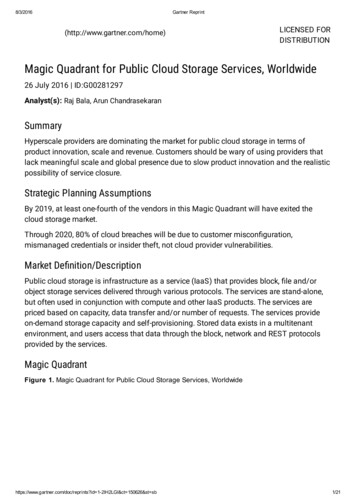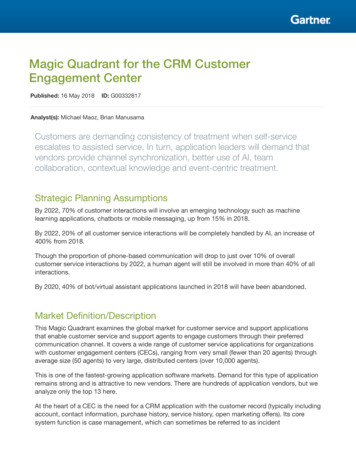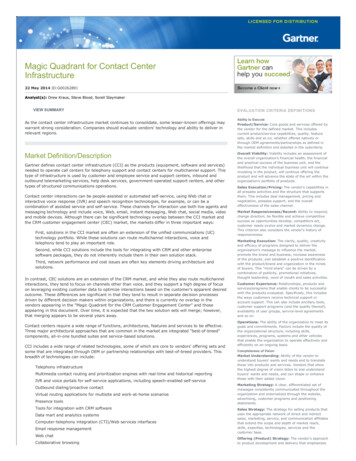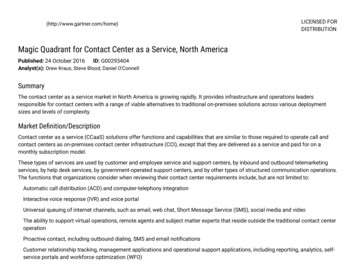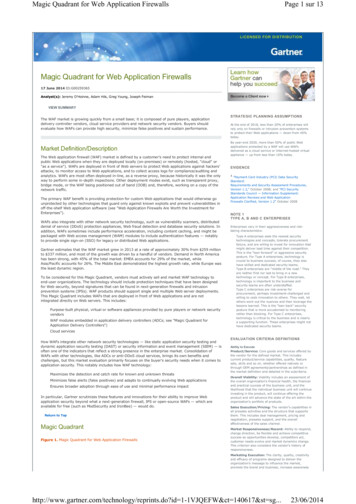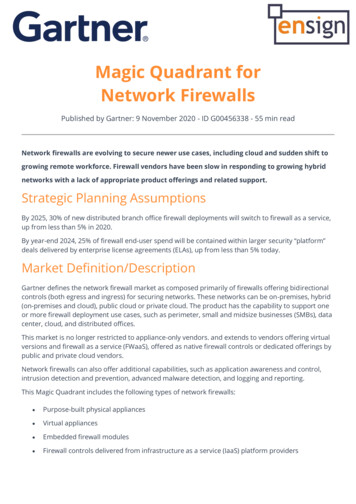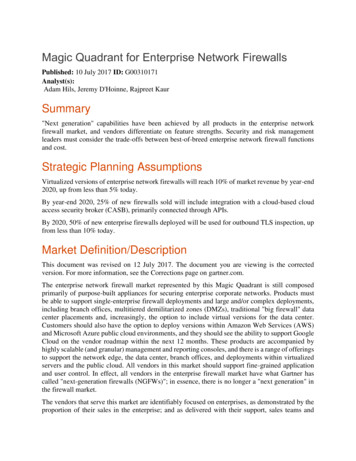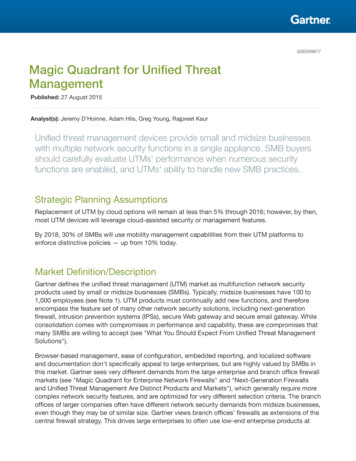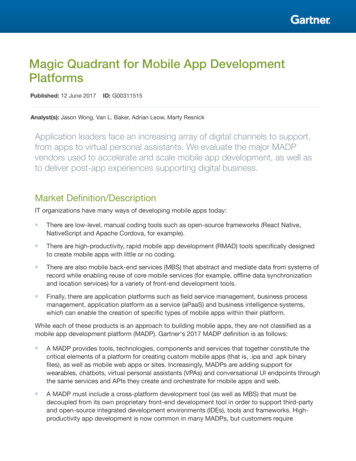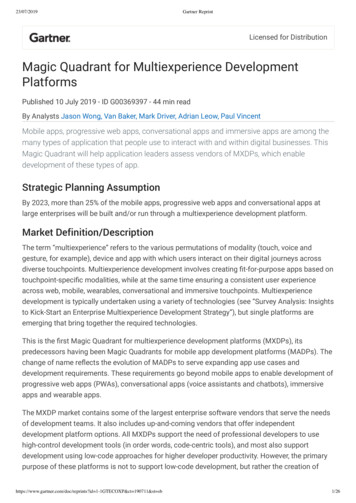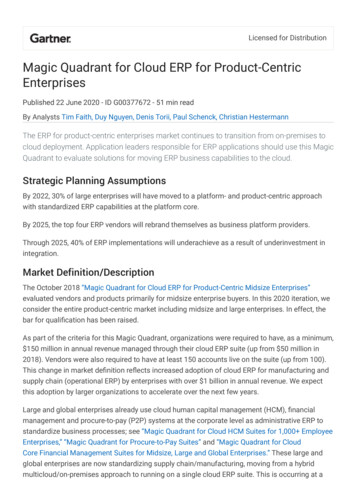
Transcription
Licensed for DistributionMagic Quadrant for Cloud ERP for Product-CentricEnterprisesPublished 22 June 2020 - ID G00377672 - 51 min readBy Analysts Tim Faith, Duy Nguyen, Denis Torii, Paul Schenck, Christian HestermannThe ERP for product-centric enterprises market continues to transition from on-premises tocloud deployment. Application leaders responsible for ERP applications should use this MagicQuadrant to evaluate solutions for moving ERP business capabilities to the cloud.Strategic Planning AssumptionsBy 2022, 30% of large enterprises will have moved to a platform- and product-centric approachwith standardized ERP capabilities at the platform core.By 2025, the top four ERP vendors will rebrand themselves as business platform providers.Through 2025, 40% of ERP implementations will underachieve as a result of underinvestment inintegration.Market Definition/DescriptionThe October 2018 “Magic Quadrant for Cloud ERP for Product-Centric Midsize Enterprises”evaluated vendors and products primarily for midsize enterprise buyers. In this 2020 iteration, weconsider the entire product-centric market including midsize and large enterprises. In effect, thebar for qualification has been raised.As part of the criteria for this Magic Quadrant, organizations were required to have, as a minimum, 150 million in annual revenue managed through their cloud ERP suite (up from 50 million in2018). Vendors were also required to have at least 150 accounts live on the suite (up from 100).This change in market definition reflects increased adoption of cloud ERP for manufacturing andsupply chain (operational ERP) by enterprises with over 1 billion in annual revenue. We expectthis adoption by larger organizations to accelerate over the next few years.Large and global enterprises already use cloud human capital management (HCM), financialmanagement and procure-to-pay (P2P) systems at the corporate level as administrative ERP tostandardize business processes; see “Magic Quadrant for Cloud HCM Suites for 1,000 EmployeeEnterprises,” “Magic Quadrant for Procure-to-Pay Suites” and “Magic Quadrant for CloudCore Financial Management Suites for Midsize, Large and Global Enterprises.” These large andglobal enterprises are now standardizing supply chain/manufacturing, moving from a hybridmulticloud/on-premises approach to running on a single cloud ERP suite. This is occurring at a
slower rate than the adoption of administrative ERP. We expect the adoption of manufacturingand operations in the cloud to accelerate in the future, but the market is still adolescent for thesedomains (see “Forecast: ERP — SaaS and On-Premises, Worldwide, 2017-2022”).Product-Centric Cloud ERP DefinitionProduct-centric organizations are typically either one of the following: Manufacturing companies: These focus on developing, manufacturing, assembling and sellingproducts, as well as delivering related services. This includes discrete products — from smalland simple consumer goods to large and complex products — and also the output of processmanufacturing, such as most food and beverages, chemicals and pharmaceuticals. Otherproduct-centric companies are active in markets such as utilities, aerospace and defense. Distribution companies: These focus on buying, storing, moving, repackaging, selling anddelivering products and their related services. Depending on the structure of their saleschannels and customers, companies in wholesale and distribution, as well as those in retail, fallinto this category.Gartner defines a product-centric cloud ERP suite as a set of loosely coupled productscomprising: Operational ERP — supply chain and manufacturing-related functionality such as demandmanagement, order management, material requirements planning (MRP), inventorymanagement, supply chain/direct procurement, manufacturing control capabilities, anddistribution/logistics. Financial management functionality (those vendors that provide only financial management asa suite are rated in a separate Magic Quadrant). Purchasing focused on indirect goods, services and capital equipment. HCM — for cost management as well as staffing for operational resources. Specialized, industry-specific modules or applications including, but not limited to, modulessuch as configure-to-order (CTO) or make-to-order (MTO), and field service management (FSM),or broader application solutions like enterprise asset management (EAM) and product life cyclemanagement (PLM).A product-centric cloud ERP suite must provide, as a minimum, operational ERP and financialmanagement functionality.Optionally, the vendor may offer other administrative ERP capabilities (such as HCM and basicpurchasing) either directly or through industry vertical packages with partners. The offering ofspecialized industry-specific modules is considered a plus, rather than a requirement, for
inclusion in this Magic Quadrant. We did not rate any specialized industry-specific modules, butwe comment on the availability of those solutions in the Vendors section.This report covers product-centric ERP products offered in a cloud service applicationdeployment. A full list of attributes for our definition of a “cloud service” is in the Inclusion andExclusion Criteria section below. To meet the criteria, the application software must be deliveredand managed remotely based on a single set of common code and data definitions, consumed insuch a way that all customers/users use the same basic application offered by the serviceprovider (e.g., a one-to-many model).The cloud service must be available for purchase on a payfor-use basis or as a subscription based on usage metrics. It must be a public cloud service thatuses shared resources to provide elasticity, and support multiple consuming organizations. Itmust also deliver “continuous innovation” through regularly scheduled, mandatory updates eachyear. All live customers must be on the same version update prior to the vendor releasing the nextversion update.The cloud service definition does not align to a specific technical architecture, such asmultitenancy at the application level (see Note 1 for the various types of technical cloudarchitecture). Survey responses and customer interactions show that end users valuefunctionality and continuous functional innovation significantly more than technical architecture.We recommend that application leaders include technical architecture — such as integrationplatform as a service (iPaaS) or platform as a service (PaaS) — as only part of the evaluationcriteria. The different architectural styles have different strengths and weaknesses. Evaluatethese capabilities against your organization’s own cloud standards.Magic QuadrantFigure 1. Magic Quadrant for Cloud ERP for Product-CentricEnterprises
Source: Gartner (June 2020)Vendor Strengths and CautionsAcumaticaHeadquartered in Bellevue, Washington, U.S., Acumatica is a “born in the cloud” ERP solution.Acumatica sells solutions through value-added resellers (VARs) and private-label OEM partners,such as Visma and MYOB, and goes to market multinationally through its partner network. Thevendor operates in multiple geographies (primarily in North America) and relies heavily onpartners for localizations. It provides cloud-delivered ERP SaaS to approximately 6500 small,midsize and larger midsize organizations, and has customers in many geographic regions.Services-centric industries are the vendor’s largest vertical segment, but product-centriccustomers are growing in number. Its resource-based licensing model is popular with customers.Recently, EQT Partners, a private equity firm that also owns IFS (another vendor in this MagicQuadrant), acquired Acumatica. While still early to define the effects of the acquisition, Acumatica
remains an independent operating unit, continuing to sell its product under the Acumatica brand.The Acumatica ERP suite 2019 R1 includes financials, field service, distribution andmanufacturing capabilities. The 2019 R1 solution is deployed in the Acumatica public cloud(running on Microsoft Azure) or a private cloud of the customer’s choice. Acumatica provides acloud development platform — the Acumatica Cloud xRP Platform — offering the integration andextensibility capabilities of a platform as a service (PaaS).Acumatica is a Niche Player in this Magic Quadrant. While suitable for, and targeted at, small andmidsize organizations, there are limitations in core functionality for larger enterprises or specificindustries. The quality of its industry-specific capability and localization compliance are bothpartner-dependent. Acumatica has been actively expanding its network of independent softwarevendor (ISV) and OEM partners. It lacks some depth of capability (in advanced technology andcomplex production planning) for larger, product-centric organizations.Strengths Acumatica received high scores from surveyed reference customers for its ability to meet theirneeds. The increasing catalog of APIs, flexibility of the Cloud xRP Platform service and range ofpartner apps align well with Gartner’s vision for postmodern ERP. Acumatica’s strong focus on midsize organizations and partner strategy is well-suited to thatmidsize market segment, enabling it to serve multiple industries and geographies. Reference customers valued the product’s ease of use and speed of initial deployment.Cautions Acumatica provides good administrative and operational ERP capabilities but is still improvingits more industry-specific capabilities, such as process manufacturing. Its dependency onpartners for industry capabilities limits its ability to deliver in some vertical markets. Acumatica offers only partial coverage in many countries beyond North America and relies onpartners to complete localization. Global enterprises searching for a single user experiencemay struggle to accomplish this through Acumatica.Epicor SoftwareEpicor Software is headquartered in Austin, Texas, U.S., and has offices in most regions of theworld. Epicor is owned by KKR, a global investment firm. Epicor provides a range of ERPapplications to over 630 customers in the manufacturing, distribution, retail and servicesindustries. The solution evaluated in this Magic Quadrant is Epicor ERP, which is aimed at a widerange of industries. The markets for Epicor products are strong in North America, the U.K. andAustralia, while the vendor has approximately 20% of its market coverage in EMEA andAsia/Pacific. Epicor ERP is sold and implemented both directly and through partners.
Epicor Software is a Visionary in this Magic Quadrant. The vendor has made progress in attractingcompanies larger than its traditional small to midsize market. It has a strong focus on cloud and agood vision for, and understanding of, the direction of cloud technology. This focus comesthrough recent acquisitions of small business software such as 1 EDI Source to enhance its cloudproduct line. However, Epicor’s execution is hindered by lack of partner implementation resourcesoutside of the North America region.Epicor has a large and loyal customer base and an active users’ group — Epicor Users Group(EUG) — both of which contribute to its success. Epicor demonstrates the ability to respond tocustomer requirements and address customers’ concerns to prioritize feature offerings in productupdates.Strengths Reference customers indicated improved confidence in the vendor’s professional service teamand their implementation support experience. With a wide range of country localizations andlanguages, Epicor supports global operations and does not rely solely on partners to localize itsproduct. Epicor has a solid operational ERP solution to support product-centric organizations, especiallyin the manufacturing and distribution space. Reference customers scored the product highlyfor its ability to deliver complex manufacturing in the cloud for the midsize and large-midsizeenterprise. Epicor can host its ERP solution in private clouds for organizations within highly regulatedindustries, and in public cloud for others.Cautions Reference customers noted that they would like Epicor to deliver more industry-specificfunctions to differentiate and innovate. Prospective customers outside of manufacturingshould plan customization or extension of functionalities through Epicor’s platform that arespecific to their industry. The availability of skilled implementation resources from partners hinders Epicor’s ability togrow outside of North America and Australia. Customers looking to expand into other regionsmay need to augment their internal skills to deploy in those regions. Rich customization capabilities, while attractive to some users, may pose a risk to Epicor’s ownability to scale and manage its SaaS support model. Customers have reported occasions onwhich Epicor has had difficulty providing timely technical support for customizedenvironments.IFSIFS is a global enterprise application software vendor with headquarters in Linkoping, Sweden. IFSis owned by EQT Partners, which acquired Acumatica (also featured in this Magic Quadrant) in
2019. At the time of this report, IFS operates independently from Acumatica. The company’sportfolio includes solutions to support ERP, FSM and EAM.The IFS Applications ERP solution is available for a wide range of industries globally and targetsmidsize to large enterprises. The current cloud version is IFS Applications 10 and is used by over150 customers across multiple geographies.IFS is a Visionary in this Magic Quadrant. This is due to its visionary product capabilities offset byissues with delivery and support for its offering. The vendor’s global customer base is larger inEMEA than in North America. IFS supports localizations in North America, EMEA andAsia/Pacific. It includes language localizations in addition to functional localization. Its singlestack solution includes a platform with extensive RESTful APIs for integration with otherplatforms, along with a partnership with Boomi. Over the past year,
or broader application solutions lik e enterprise asset management (EAM) and pr oduct life cycle management (PLM). inclusion in this Magic Quadrant. We did not rate any specializ ed industr y-specific modules, but we comment on the a vailability of those solutions in the V endors section. This repor t covers product-centric ERP pr oducts offered in a cloud ser vice application deployment. A .


